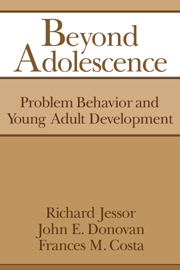3 - Following up lives
Published online by Cambridge University Press: 07 October 2009
Summary
This book reports the second phase of an ongoing, long-term, prospective longitudinal study that followed the lives of two samples – one of junior high school students, and the other of college freshmen – over an extended period of time, from the late 1960s and early 1970s into the early 1980s. During that time, repeated assessments were made of personality, social, and behavioral aspects of development from adolescence/youth into young adulthood.
For both samples, data were collected at six different times over an 11- or 12-year period. The first four data collections were carried out on an annual basis within the life stage of adolescence or youth; results from that initial phase of the overall longitudinal study were reported in Jessor and Jessor (1977). The fifth and sixth data collections were carried out in the later phase of the longitudinal study which took place within the life stage of young adulthood.
In this chapter, we describe the design of the overall study, the samples involved in the second phase of the study, and the comprehensive questionnaire that was developed for use with participants who had become young adults.
Overall design of the study
The design of the two, parallel, six-wave longitudinal studies of the High School and College samples is shown in Figure 3.1 and 3.2, respectively. As may be seen, the High School Study is based on a cohort-sequential longitudinal design, whereas the College Study is based on a simple longitudinal design.
- Type
- Chapter
- Information
- Beyond AdolescenceProblem Behaviour and Young Adult Development, pp. 39 - 66Publisher: Cambridge University PressPrint publication year: 1992



